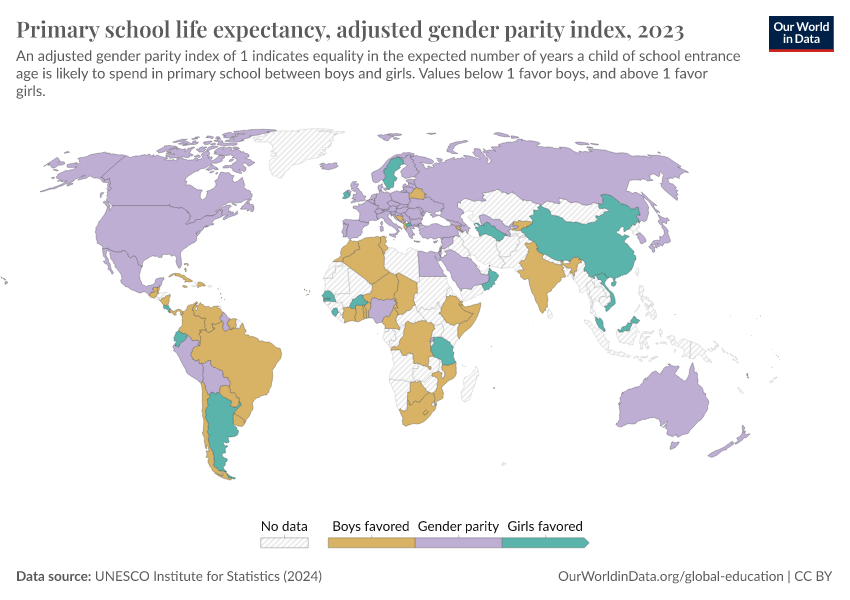Primary school life expectancy, adjusted gender parity index

What you should know about this indicator
- In many countries, boys and girls do not spend the same amount of time in primary school — this indicator shows how close they are to parity in expected school duration at the primary level.
- It focuses specifically on school life expectancy in primary education, comparing the average number of years girls and boys are expected to spend in primary school based on current age-specific enrolment rates.
- The adjusted gender parity index (GPIA) is calculated by dividing the female school life expectancy in primary education by the male school life expectancy. If the result exceeds 1, it is inverted and subtracted from 2 to produce a symmetrical scale from 0 to 2, with 1 representing perfect parity.
- A value of 1 means boys and girls are expected to spend the same number of years in primary school. Values below 1 indicate boys are expected to spend more time in school; values above 1 indicate girls are.
- This indicator assumes current enrolment trends continue over time and includes all children, even those who may never enrol, giving a comprehensive view of participation in primary education.
- The data comes from administrative sources such as school censuses and registers, as well as population estimates by age, typically provided by national statistical offices or the United Nations Population Division.
- Disaggregated by sex, this indicator helps identify gender gaps in access to and retention in primary schooling.
- As with all expectancy-based indicators, it does not reflect actual completion or quality of education and may not account for repetition or part-time attendance, which can vary across contexts.
What you should know about this indicator
- In many countries, boys and girls do not spend the same amount of time in primary school — this indicator shows how close they are to parity in expected school duration at the primary level.
- It focuses specifically on school life expectancy in primary education, comparing the average number of years girls and boys are expected to spend in primary school based on current age-specific enrolment rates.
- The adjusted gender parity index (GPIA) is calculated by dividing the female school life expectancy in primary education by the male school life expectancy. If the result exceeds 1, it is inverted and subtracted from 2 to produce a symmetrical scale from 0 to 2, with 1 representing perfect parity.
- A value of 1 means boys and girls are expected to spend the same number of years in primary school. Values below 1 indicate boys are expected to spend more time in school; values above 1 indicate girls are.
- This indicator assumes current enrolment trends continue over time and includes all children, even those who may never enrol, giving a comprehensive view of participation in primary education.
- The data comes from administrative sources such as school censuses and registers, as well as population estimates by age, typically provided by national statistical offices or the United Nations Population Division.
- Disaggregated by sex, this indicator helps identify gender gaps in access to and retention in primary schooling.
- As with all expectancy-based indicators, it does not reflect actual completion or quality of education and may not account for repetition or part-time attendance, which can vary across contexts.
Sources and processing
This data is based on the following sources
How we process data at Our World in Data
All data and visualizations on Our World in Data rely on data sourced from one or several original data providers. Preparing this original data involves several processing steps. Depending on the data, this can include standardizing country names and world region definitions, converting units, calculating derived indicators such as per capita measures, as well as adding or adapting metadata such as the name or the description given to an indicator.
At the link below you can find a detailed description of the structure of our data pipeline, including links to all the code used to prepare data across Our World in Data.
Reuse this work
- All data produced by third-party providers and made available by Our World in Data are subject to the license terms from the original providers. Our work would not be possible without the data providers we rely on, so we ask you to always cite them appropriately (see below). This is crucial to allow data providers to continue doing their work, enhancing, maintaining and updating valuable data.
- All data, visualizations, and code produced by Our World in Data are completely open access under the Creative Commons BY license. You have the permission to use, distribute, and reproduce these in any medium, provided the source and authors are credited.
Citations
How to cite this page
To cite this page overall, including any descriptions, FAQs or explanations of the data authored by Our World in Data, please use the following citation:
“Data Page: Primary school life expectancy, adjusted gender parity index”, part of the following publication: Hannah Ritchie, Veronika Samborska, Esteban Ortiz-Ospina, and Max Roser (2023) - “Global Education”. Data adapted from UNESCO Institute for Statistics. Retrieved from https://archive.ourworldindata.org/20250909-093708/grapher/school-life-expectancy-primary-gender-parity-index-gpi.html [online resource] (archived on September 9, 2025).How to cite this data
In-line citationIf you have limited space (e.g. in data visualizations), you can use this abbreviated in-line citation:
UNESCO Institute for Statistics (2025) – with minor processing by Our World in DataFull citation
UNESCO Institute for Statistics (2025) – with minor processing by Our World in Data. “Primary school life expectancy, adjusted gender parity index” [dataset]. UNESCO Institute for Statistics, “UNESCO Institute for Statistics (UIS) - Education” [original data]. Retrieved January 8, 2026 from https://archive.ourworldindata.org/20250909-093708/grapher/school-life-expectancy-primary-gender-parity-index-gpi.html (archived on September 9, 2025).